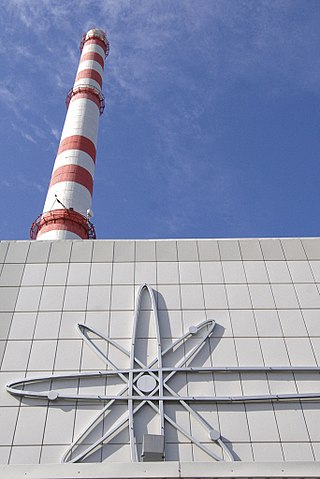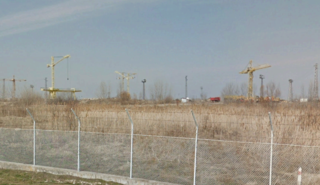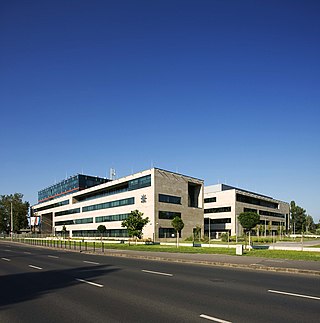
A nuclear power plant (NPP) is a thermal power station in which the heat source is a nuclear reactor. As is typical of thermal power stations, heat is used to generate steam that drives a steam turbine connected to a generator that produces electricity. As of September 2023, the International Atomic Energy Agency reported there were 410 nuclear power reactors in operation in 31 countries around the world, and 57 nuclear power reactors under construction.

Rosatom, also known as Rosatom State Nuclear Energy Corporation, the State Atomic Energy Corporation Rosatom, or Rosatom State Corporation, is a Russian state corporation headquartered in Moscow that specializes in nuclear energy, nuclear non-energy goods and high-tech products. Established in 2007, the nonprofit organization comprises more than 350 enterprises, including scientific research organizations, a nuclear weapons complex, and the world's only nuclear icebreaker fleet.

The Paks Nuclear Power Plant is located 5 kilometres (3.1 mi) from the small town of Paks, central Hungary, 100km southwest of Budapest on the shores of the Danube river. It is the first and only operating nuclear power station in Hungary. In 2019, its four reactors produced more than 50% of Hungary's electricity production.

The Kozloduy Nuclear Power Plant is a nuclear power plant in Bulgaria situated 180 kilometres (110 mi) north of Sofia and 5 kilometres (3.1 mi) east of Kozloduy, a town on the Danube river, near the border with Romania. It is the country's only nuclear power plant and the largest in the region. The construction of the first reactor began on 6 April 1970.

The water-water energetic reactor (WWER), or VVER is a series of pressurized water reactor designs originally developed in the Soviet Union, and now Russia, by OKB Gidropress. The idea of such a reactor was proposed at the Kurchatov Institute by Savely Moiseevich Feinberg. VVER were originally developed before the 1970s, and have been continually updated. As a result, the name VVER is associated with a wide variety of reactor designs spanning from generation I reactors to modern generation III+ reactor designs. Power output ranges from 70 to 1300 MWe, with designs of up to 1700 MWe in development. The first prototype VVER-210 was built at the Novovoronezh Nuclear Power Plant.

Russia is one of the world's largest producers of nuclear energy. In 2020 total electricity generated in nuclear power plants in Russia was 215.746 TWh, 20.28% of all power generation. The installed gross capacity of Russian nuclear reactors is 29.4 GW in December 2020.

The Belene Nuclear Power Plant is a planned nuclear power plant 3 km from Belene and 11 km from Svishtov in Pleven Province, northern Bulgaria, near the Danube River. It was intended to substitute four VVER-440 V230 reactors of the Kozloduy Nuclear Power Plant that were decommissioned as a prerequisite for Bulgaria to join the European Union.
As of 2022, nuclear power is provided by six commercial nuclear power plants in Pakistan. Pakistan is the first Muslim majority country in the world to construct and operate civil nuclear power plants. The Pakistan Atomic Energy Commission (PAEC), the scientific and nuclear governmental agency, is solely responsible for operating these power plants. As of 2018, the electricity generated by commercial nuclear power plants constitutes roughly 7.5% of electricity generated in Pakistan, Pakistan is not a party to the Nuclear Non-Proliferation Treaty but is a member of the International Atomic Energy Agency. Pakistan plans on constructing 32 nuclear power plants by 2050 and envisions 40,000 MW of nuclear power generation.

The Czech Republic operates two nuclear power plants: Temelín and Dukovany. As of 2019 the government intends to increase the share of nuclear electricity production from 30 % to 58 %. To this end, a new reactor is to be constructed at the Dukovany site, which will replace older units by 2035. New capacities are also expected to be added at the Temelín site.

China is one of the world's largest producers of nuclear power. The country ranks third in the world both in total nuclear power capacity installed and electricity generated, accounting for around one tenth of global nuclear power generated. As of February 2023, China has 55 plants with 57GW in operation, 22 under construction with 24 GW and more than 70 planned with 88GW. About 5% of electricity in the country is due to nuclear energy. These plants generated 417 TWh of electricity in 2022 This is versus the September 2022 numbers of 53 nuclear reactors, with a total capacity of 55.6 gigawatt (GW). In 2019, nuclear power had contributed 4.9% of the total Chinese electricity production, with 348.1 TWh.

Tianwan Nuclear Power Plant is a nuclear power plant (NPP) in the city of Lianyungang in Jiangsu Province, China. It is located on the coast of the Yellow Sea approximately 30 kilometers east of downtown Lianyungang. It is owned by Jiangsu Nuclear Power Corporation, a joint venture mainly owned by the China National Nuclear Power Co., Ltd (CNNP),subsidiary of China National Nuclear Corporation (CNNC).

Rheinsberg Nuclear Power Station was the second nuclear reactor in East Germany after the Rossendorf Research Reactor, and the first nuclear power reactor in East Germany. It was built close to the city of Rheinsberg on the Stechlinsee. The power station was one of the first generation of demonstration power reactors. Following the shutdown of Rheinsberg nuclear power plant, power generation in Germany is primarily dependent on natural gas, coal and other fossil fuels, predominantly sourced from Russia.

MVM Group is a Hungarian power company, and has a Hungarian monopoly for the production, distribution and sale of electricity.

As a member of the nuclear non-proliferation treaty, South Africa uses nuclear science for peaceful means. South Africa's nuclear programme includes both nuclear energy and nuclear medicine. In the past there was also a military component, and South Africa previously possessed nuclear weapons, which were subsequently dismantled.

Ukraine operates four nuclear power plants with 15 reactors located in Volhynia and South Ukraine. The total installed nuclear power capacity is over 13 GWe, ranking 7th in the world in 2020. Energoatom, a Ukrainian state enterprise, operates all four active nuclear power stations in Ukraine. In 2019, nuclear power supplied over 20% of Ukraine's energy.
President Adly Mansour announced on 7 November 2013 that Egypt was restarting its nuclear power program in El Dabaa; a deal was reached with the residents in which it was agreed that a residential area will also be built. The Egyptian minister of electricity, Ahmed Emam, has called the project "necessary" because of a small amount of renewable energy sources and not enough fuel.
Slovakia has five operational nuclear reactors, with a combined net power capacity of 2,308 MWe, with a sixth coming on line shortly.

Poland currently operates a single research reactor, Maria. It has no operational nuclear reactors for power production, but is to start construction of a plant with three Westinghouse AP1000 reactors in 2026, and is also intending to build small modular reactors.
The Ninh Thuận 1 Nuclear Power Plant was a planned nuclear power plant at Phước Dinh in Thuận Nam District, Ninh Thuận Province, Vietnam. Plans for it were cancelled in 2016. It would have consisted of four 1,200 MWe VVER pressurised water reactors. The plant was to be built by Atomstroyexport, a subsidiary of Rosatom. It would have been owned and operated by state-owned electricity company Vietnam Electricity. Fuel will have been supplied and used fuel will be reprocessed by Rosatom. The feasibility study was to be carried out by E4 Group.















